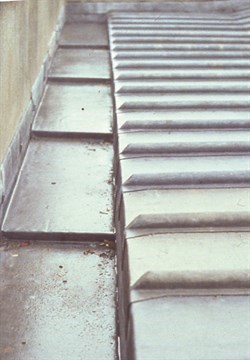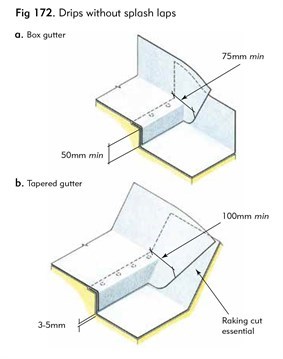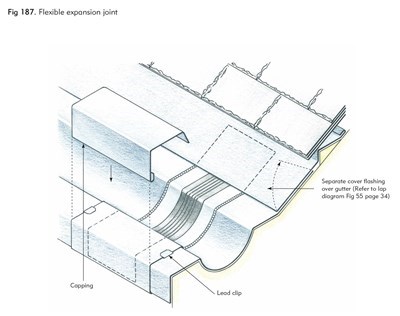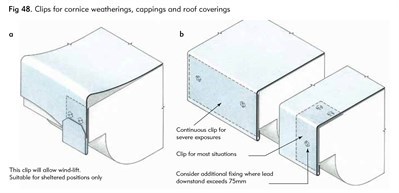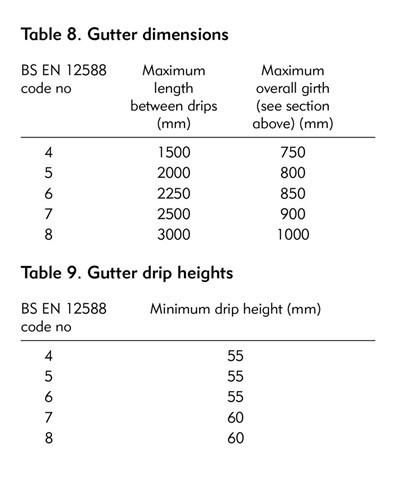The use of rubber expansion joints in lead guttering
[edit] Lead guttering: A flexible approach
A question that is often asked of professionals is about the correct way to fit a lead gutter. Should they be fitted in the traditional way with drips (steps) breaking up the lengths or can rubber expansion joints be used?
[Example of a typical box gutter]
One answer is that if it can be done the traditional way then it should be. However, if the situation means this can’t be done, there may be no choice other than to use an alternative method.
So what is a rubber expansion joint and when should it be used?
To a certain extent, the answer lies in its history. Neoprene expansion joints, to give them their proper name, were first used in Europe in conjunction with zinc and copper gutter linings. The idea being that a method of jointing was needed to take into account the thermal expansion of certain types of metals. Traditional methods for jointing copper gutters, again with steps along its length, could not be easily replicated in zinc as the material is not as malleable.
In the early-1990s, the same principle was introduced to leadwork. The reason for this was that traditional wall head gutters that were made from concrete and lined with lead, which can be found on many older buildings, needed the leadwork replaced.
Traditionally, the lead lining pieces were just lapped and water ingress was inevitable. As it was impossible to create the traditional steps in these installations, neoprene expansion joints were seen as a good solution.
Over the years, these types of joints have been applied in many different gutter situations and appear to be giving a good service life to date. Their popularity has grown given that they can be welded into place much faster than using traditional ‘bossing’ methods to form the drips.
[edit] Why is that a problem?
One of the main reasons that we refer to these as a ‘last resort’ is that they only carry a manufacturers guarantee of 5 - 10 years. Lead on the other hand is expected to give a service life in excess of 60 - 100 years.
Having a component within this that may have a shorter lifespan is an obvious weak point and one that should be avoided if possible. Their use should be restricted to places where there is no choice, as it may restrict any insurance backed guarantees and could, in certain circumstances, lead to costly replacement works which would require full scaffold access.
All leadworks should take into account the anticipated life of the building concerned. Where a shorter service life may be acceptable to a building owner or developer the use of neoprene expansion joints could be considered. By contrast, where maximum service life is required standard traditional details should always be used. If neoprene joints are proposed, this should be discussed with the client and built into any maintenance programme.
All the details used here are from the LSA's Complete Manual, which includes a wealth of detail on installation and specification. Further information and technical support is available at www.leadsheet.co.uk.
This article was written by Darren Tutt, Senior Technical Officer, The Lead Sheet Association
NB: Any detailing provided by the Lead Sheet Association refers to the use of Rolled Lead Sheet to BS EN 12588.
[edit] Related articles on Designing Buildings Wiki
Featured articles and news
The UK's Modern Industrial Strategy: A 10 year plan
Previous consultation criticism, current key elements and general support with some persisting reservations.
Building Safety Regulator reforms
New roles, new staff and a new fast track service pave the way for a single construction regulator.
Architectural Technologist CPDs and Communications
CIAT CPD… and how you can do it!
Cooling centres and cool spaces
Managing extreme heat in cities by directing the public to places for heat stress relief and water sources.
Winter gardens: A brief history and warm variations
Extending the season with glass in different forms and terms.
Restoring Great Yarmouth's Winter Gardens
Transforming one of the least sustainable constructions imaginable.
Construction Skills Mission Board launch sector drive
Newly formed government and industry collaboration set strategy for recruiting an additional 100,000 construction workers a year.
New Architects Code comes into effect in September 2025
ARB Architects Code of Conduct and Practice available with ongoing consultation regarding guidance.
Welsh Skills Body (Medr) launches ambitious plan
The new skills body brings together funding and regulation of tertiary education and research for the devolved nation.
Paul Gandy FCIOB announced as next CIOB President
Former Tilbury Douglas CEO takes helm.
UK Infrastructure: A 10 Year Strategy. In brief with reactions
With the National Infrastructure and Service Transformation Authority (NISTA).
Ebenezer Howard: inventor of the garden city. Book review.
The Grenfell Tower fire, eight years on
A time to pause and reflect as Dubai tower block fire reported just before anniversary.
Airtightness Topic Guide BSRIA TG 27/2025
Explaining the basics of airtightness, what it is, why it's important, when it's required and how it's carried out.
Construction contract awards hit lowest point of 2025
Plummeting for second consecutive month, intensifying concerns for housing and infrastructure goals.
Understanding Mental Health in the Built Environment 2025
Examining the state of mental health in construction, shedding light on levels of stress, anxiety and depression.






